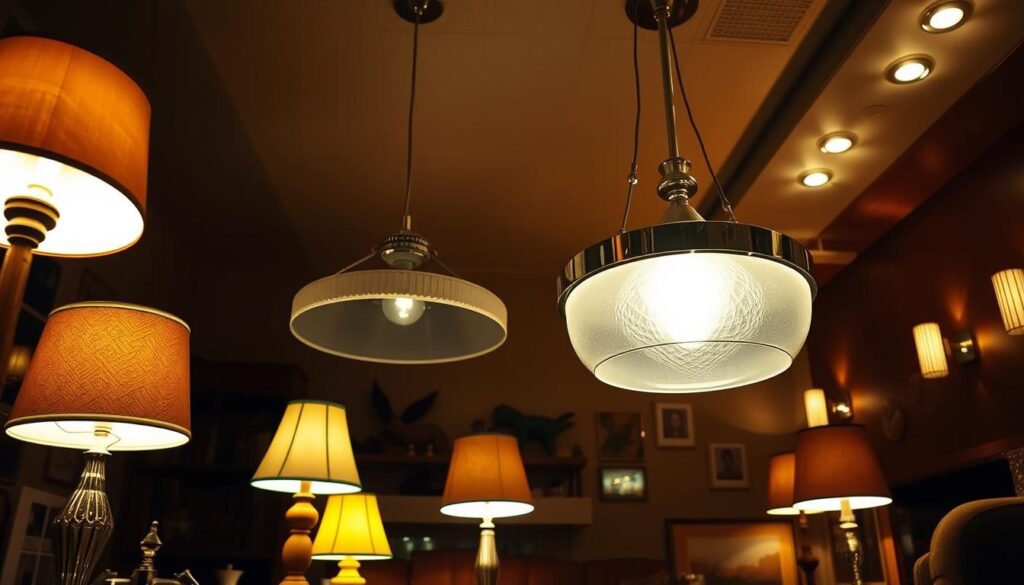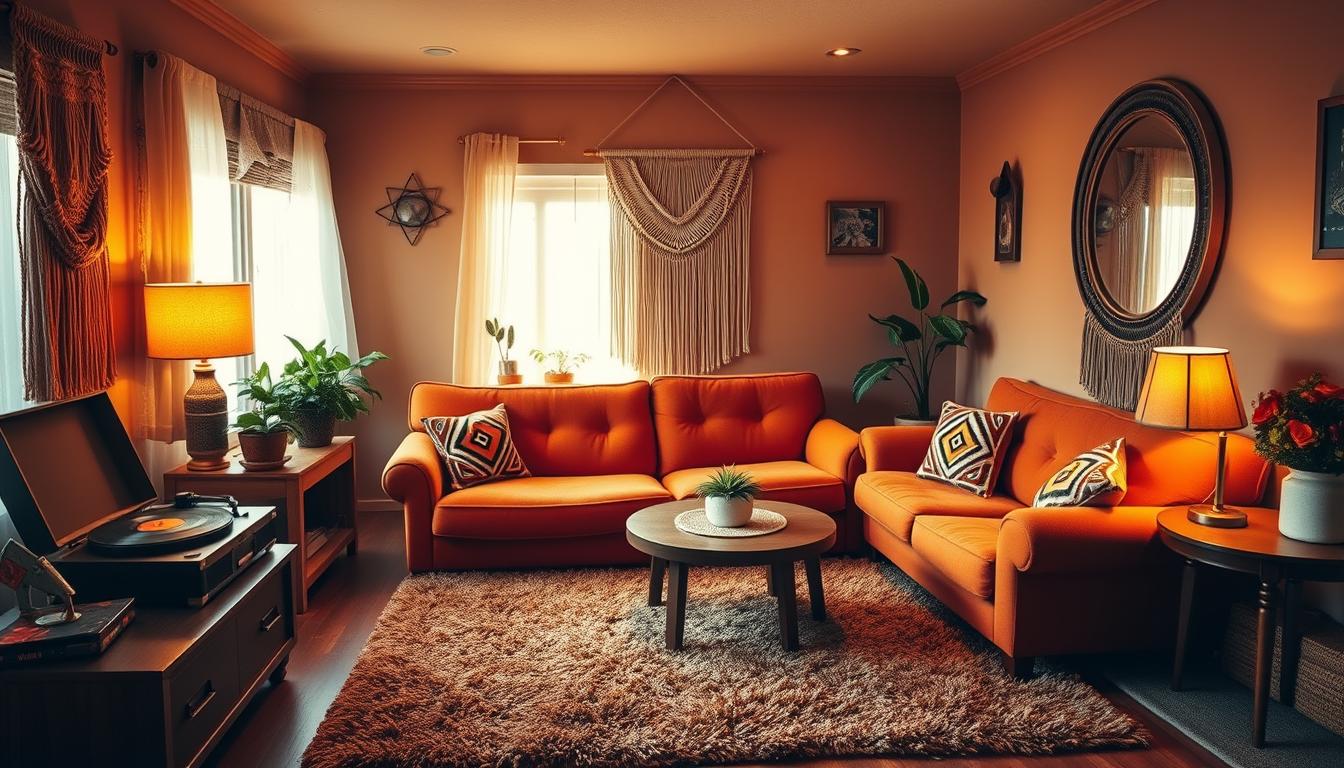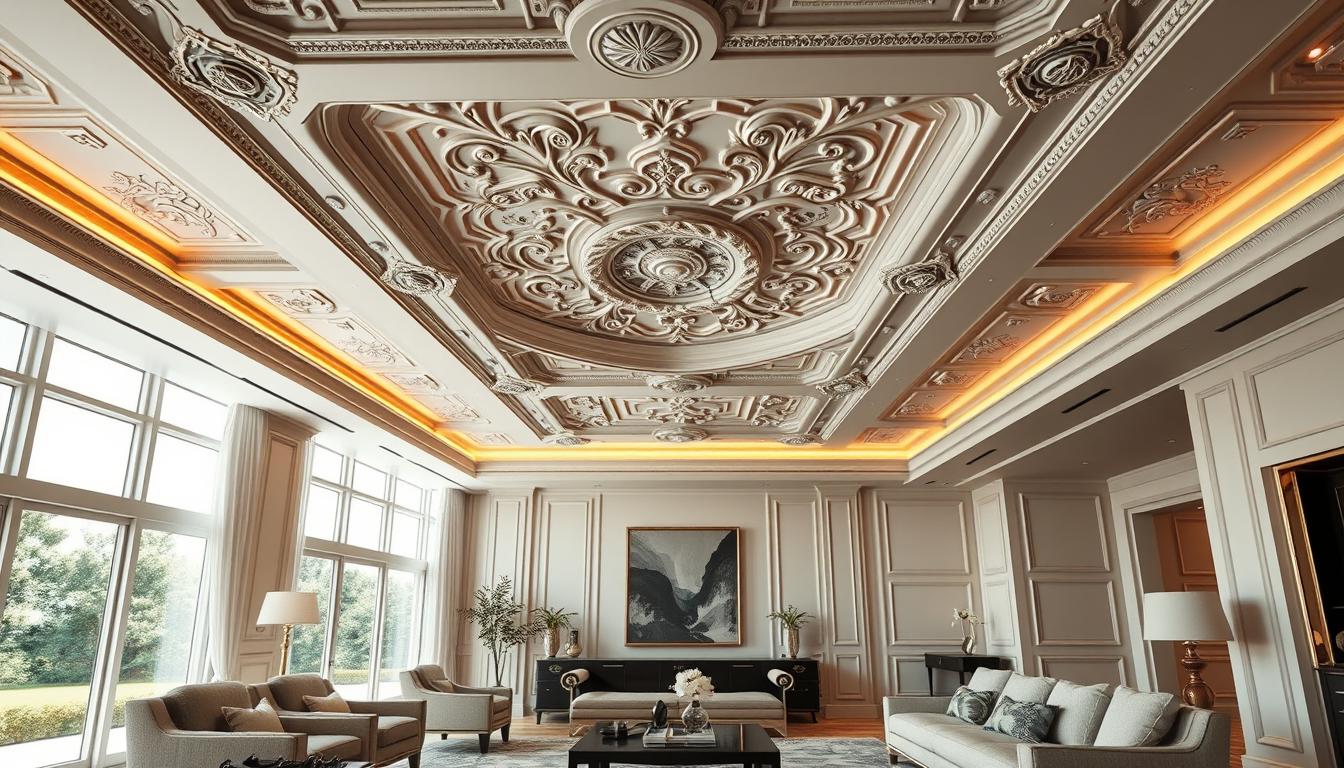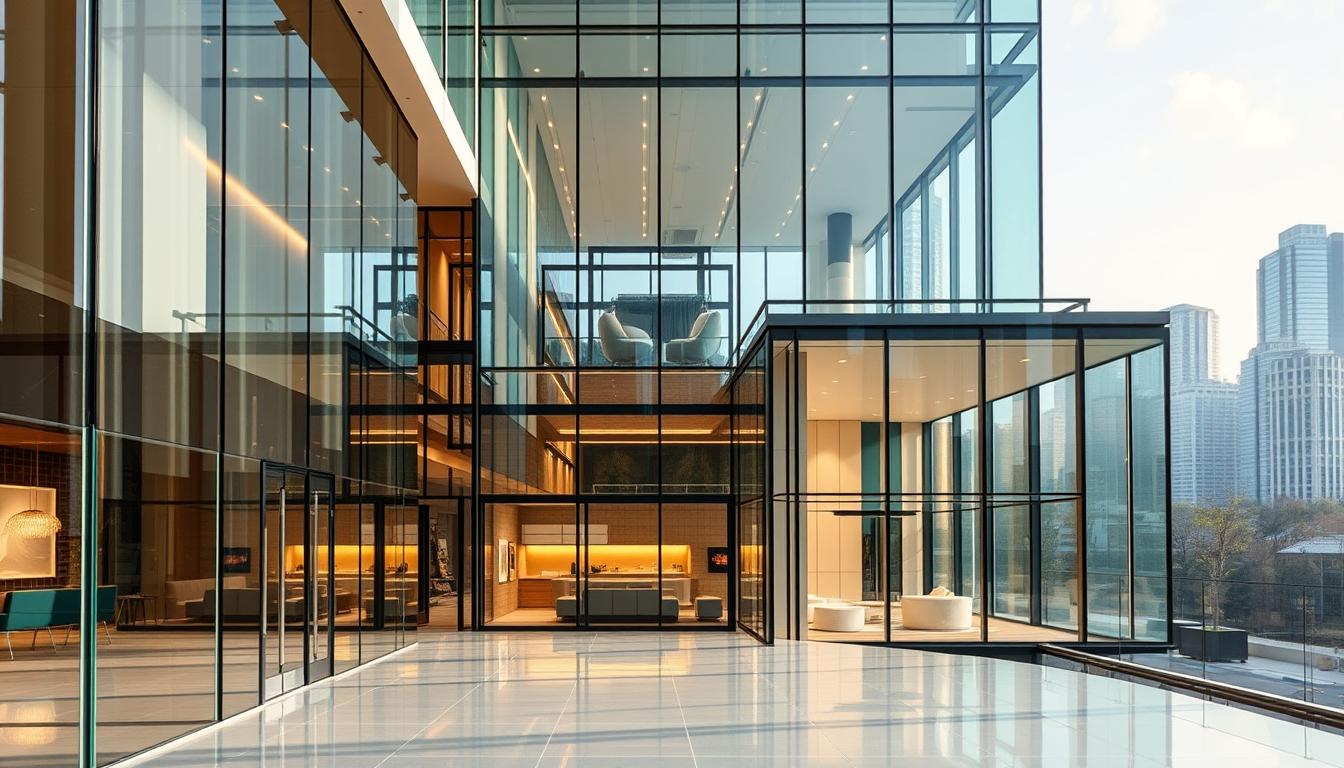The 1970s were a time of bold expression. This was seen in the decade’s retro home decor. It featured vibrant colors, funky patterns, and unique textures, making interiors truly unique.
We can bring back this retro charm by adding key elements of 1970s style to our homes. By embracing the decade’s eclectic and self-expressive nature, we can create unique and stylish interiors that stand out.
To get started, we’ll explore the defining features of 1970s interior design. We’ll see how to blend them into modern home decor.
Key Takeaways
- Understand the core elements of 1970s retro style
- Learn how to incorporate bold colors and patterns into your decor
- Discover unique textures that can add depth to your space
- Find out how to balance retro elements with modern design
- Create a stylish and eclectic interior that reflects your personality
Understanding 1970s Home Interior Design Trends
The 1970s home interior design was a mix of pop culture, new materials, and bold colors. It focused on warmth and coziness, making homes welcoming.
Pop Culture Influence on Design Choices
Pop culture was big in 1970s interior design. The decade’s vibrant styles came from music, movies, and fashion. Designers used bold statements and funky patterns to reflect the era.
The decade’s love for bright colors, funky patterns, and new materials showed in design. It was a time when creativity in design was limitless.
Key Materials Dominating the Era
The 1970s introduced many materials in interior design. Natural materials like wood and stone were popular, along with man-made ones like vinyl and chrome. These materials mixed modernity with warmth in homes.
| Material | Common Use | Characteristics |
|---|---|---|
| Wood | Furniture, Paneling | Warmth, Durability |
| Vinyl | Furniture Upholstery, Flooring | Durable, Easy to Clean |
| Chrome | Lighting, Decorative Accents | Modern, Reflective |
Iconic Color Palettes
The 1970s were known for their unique color palettes. Earthy tones like burnt orange, avocado green, and mustard yellow were common. These colors made spaces cozy and inviting.
These iconic colors, along with bold patterns and textures, defined 1970s design. Understanding these elements helps us appreciate the era’s unique style and its lasting influence on design.
Essential Elements of 1970s Décor
The 1970s décor was shaped by mid-century modern ideas. This era was all about trying new things and showing who you are through design.
The 1970s were known for bold patterns and textures. These made rooms interesting and deep. You’d see geometric shapes, florals, and paisleys on furniture, rugs, and walls. These patterns were mixed with different textures like velvet, shag carpet, and wood to make rooms feel rich and layered.
Bold Patterns and Textures
Bold patterns and textures were key in 1970s décor. Designers and homeowners loved exploring many styles. Paisley patterns and geometric shapes were popular, along with different textures like velvet and shag carpet. These added a special touch to rooms.
Statement Lighting Fixtures
Lighting in the 1970s was more than just functional. It was a way to express creativity. Globe pendant lights, sputnik chandeliers, and lava lamps were big hits. They were used to make rooms stand out, adding glamour and sophistication.
The Use of Natural and Man-Made Materials
The 1970s mixed natural and man-made materials in design. Wood, brick, and stone brought warmth and a natural feel to homes. At the same time, materials like plastic, glass, and metal added a modern touch. This mix made 1970s décor interesting and varied.
Incorporating Earthy Tones into Your Space
To bring 1970s interior design into your home, start with earthy tones. Colors like burnt orange, avocado green, and mustard yellow were key in the 1970s. These warm hues make a space cozy and inviting.
Choosing the Right Color Combinations
When picking earthy tones, it’s crucial to pair them well. Avocado green decor and burnt orange look great with neutral shades like beige or cream. This prevents the space from feeling too busy.
Here are some color combinations to consider:
| Color 1 | Color 2 | Color 3 |
|---|---|---|
| Burnt Orange | Avocado Green | Beige |
| Mustard Yellow | Earth Brown | Cream |
| Terracotta | Sienna | Soft Gray |
Using Paint to Transform Your Rooms
Paint is a great way to change a room’s feel. The right earthy tones can make a room cozy and welcoming. For example, a burnt orange room is perfect for a living or dining area.
Think about the room’s natural light when painting. Rooms with lots of light can handle deeper colors. Rooms with less light might need lighter shades to avoid feeling dark.
By using paint and other design elements, you can make your home warm and welcoming. It will be a tribute to the 1970s design era.
Furniture Styles that Define the 1970s
Low-slung furniture, velvet sofas, and leather chairs were key in 1970s home interior design. The decade focused on comfort and relaxation. This is seen in its furniture trends.
To capture the 1970s vibe in your home, certain furniture is crucial. Let’s dive into the era’s décor highlights.
Key Pieces to Look For
The disco era design had unique furniture styles. Some standout pieces include:
- Low-slung sofas and chairs for ultimate relaxation
- Velvet sofas in vibrant, bold colors
- Leather chairs and ottomans for a sophisticated look
- Macramé and woven furniture for a natural vibe
Vintage vs. Modern Replicas
When adding 1970s furniture to your home, you have two choices: vintage or modern replicas. Vintage furniture brings authenticity but might need restoration and is pricey. Modern replicas are cheaper and durable, yet still capture the era’s design.
We suggest combining vintage and modern pieces. This creates a unique, balanced look that honors the 1970s while meeting today’s needs.
Accessorizing with Vintage 1970s Décor
Adding vintage 1970s décor to your home brings a unique vibe. The 1970s were all about bold colors, eclectic patterns, and mixing natural and man-made materials. This era’s creativity in interior design is still inspiring today.
Artwork and Wall Hangings
Artwork and wall hangings were key in 1970s décor. They often had bold graphics, abstract shapes, and varied textures. Think about vintage posters, macramé wall hangings, or abstract art that captures the era’s spirit.
When picking artwork, look for pieces with iconic 1970s colors like earthy tones, avocado green, and harvest gold. These colors will tie your vintage accessories to your overall décor.
Pillows and Throws: A Pop of Color
Pillows and throws were big in 1970s design for adding color and texture. You can find vintage ones in many patterns, from paisley and florals to geometric and abstract designs.
To use vintage pillows and throws well, mix different patterns and textures. This mix-and-match style was a 1970s hallmark. It adds depth and visual interest to your space.
| Vintage Item | Description | How to Incorporate |
|---|---|---|
| Vintage Posters | Feature bold graphics and colors | Frame and hang in a prominent area |
| Macramé Wall Hangings | Add texture with intricate knotting | Use as a statement piece above a sofa or bed |
| Vintage Pillows and Throws | Offer a variety of patterns and textures | Mix and match on sofas and chairs |
By carefully adding these vintage elements, you can make a space that feels nostalgic and retro. Yet, it will also be functional and stylish.
Embracing the Open Concept Floor Plan
The open concept floor plan was a big deal in the 1970s. It was all about freedom and flow. Today, we can make our homes feel bigger and more connected by embracing this idea.
Benefits of Open Spaces
Open concept homes feel bigger and are great for socializing. Without walls, they feel airy and open. This is perfect for small homes or for those who love to entertain.
A key advantage is being able to chat with family and friends while moving around. It also lets natural light spread out, making the space brighter.
Furniture Layout Ideas
Furnishing an open space requires smart planning. Use furniture to create zones, like a living area and kitchen. Area rugs help define these spaces and add warmth.
Choose furniture that fits the room well. Big pieces can clutter, while too many small ones can disrupt the flow. Make sure the room looks balanced, so no area feels too dominant.

With careful furniture selection and placement, we can create a beautiful open concept space. It captures the 1970s vibe while meeting today’s needs.
The Role of Nature in 1970s Interiors
Nature was key in 1970s interiors, focusing on organic elements. This era wanted to merge the outdoors with indoors. It aimed for a seamless blend of natural and built environments.
Indoor Plants as Essential Accessories
Indoor plants were a must-have in 1970s homes. They were not just for looks but also to purify the air and bring calm. Ferns, peace lilies, and spider plants were favorites, often in hanging baskets or macramé plant holders.
Bringing the Outdoors Inside
The 1970s also used natural materials in interiors. Rattan and wicker furniture added warmth and texture. Wood, stone, and brick were also used, making spaces feel more like outdoors.
To get a similar vibe at home, look for mid-century modern pieces with organic shapes and natural materials. Add lots of indoor plants and natural textiles. This will make your space cozy and inviting, just like the 1970s.
The 1970s’ design approach to nature is still inspiring today. It offers a mix of retro style and eco-friendly living. This blend is perfect for those who love both the past and the planet.
Modernizing 1970s Design Elements
Bringing the 1970s back into our homes is all about mixing old charm with new style. We can do this by adding avocado green decor and disco era design to today’s designs.
Merging Vintage with Contemporary Styles
To mix old with new, pick a few standout vintage pieces. Think about a vintage armchair or a retro rug. Then, pair these with modern furniture for a look that’s both unique and balanced.
- Look for vintage items that show off the 1970s vibe, like bold patterns or earthy colors.
- Match these vintage finds with modern decor that enhances their look without copying it.
- Make sure the size and shape of both old and new pieces work well together for a smooth mix.
For more ideas on how to bring 1970s style into today’s homes, check out our article on the topic.
Tips for a Balanced Aesthetic
Creating a balanced look with 1970s design elements means paying attention to a few key things. First, find a good balance between old and new to avoid cluttering the space.
- Begin with a neutral base: Use a simple color scheme on walls and big furniture to create a calm space for both old and new.
- Add vintage pieces carefully: Bring in vintage items slowly, making sure they fit well with the modern pieces.
- Be mindful of textures and patterns: Mixing different textures and patterns can enrich a room, but don’t overdo it.
By carefully combining vintage 1970s design with today’s styles and following these tips, you can make a space that’s both nostalgic and fresh. This mix honors the past while adding a special touch to your home.
Key Lighting Techniques Inspired by the 1970s
To capture the essence of 1970s home interior design, we must look at the era’s lighting solutions. The 1970s were a time when lighting became a key feature of interior spaces. It often served as a statement piece, showing the era’s flair for the dramatic and eclectic.
Retro Light Fixtures to Consider
The 1970s were known for bold and sometimes unconventional lighting fixtures. Some iconic options to consider include:
- Globe pendant lights, which added a touch of elegance and sophistication to rooms.
- Lava lamps, a staple of 1970s decor that brought a psychedelic ambiance to spaces.
- Sputnik chandeliers, characterized by their multiple arms and bulbs, creating a dramatic focal point.

Layering Light for Effect
Layering light was a technique used in 1970s interior design to create depth and visual interest in a room. This involved combining different light sources, such as overhead lighting, table lamps, and floor lamps. It aimed to achieve a warm and inviting atmosphere.
| Lighting Type | Purpose | Examples |
|---|---|---|
| Ambient Lighting | Provides overall illumination | Ceiling fixtures, Chandeliers |
| Task Lighting | Focused light for specific tasks | Desk lamps, Reading lamps |
| Accent Lighting | Highlights decorative elements | Spotlights, Picture lights |
By incorporating these retro lighting techniques into your home, you can evoke the spirit of the 1970s. This creates a unique and captivating interior design.
Sustainable Choices in 1970s Inspired Design
The 1970s were all about living green, using eco-friendly materials and upcycling old items. Today, we can bring back this green vibe in our homes. It’s a great way to make our living spaces unique and eco-friendly.
Eco-Friendly Materials to Use
In the 1970s, homes were decorated with natural and green materials. Some top picks include:
- Reclaimed wood for furniture and flooring
- Bamboo for decorative accents and furniture
- Cotton and linen for upholstery and drapes
- Natural fibers like jute and sisal for rugs
These materials add warmth and texture to any room. They also help us live more sustainably. By choosing them, we make our homes healthier and kinder to the planet.
Vintage Upcycling Ideas
Upcycling old items is a fun way to give them new life. Here are some cool ideas to try:
- Turn old pallets into coffee tables or shelves
- Use vintage windows as room dividers or wall art
- Make unique storage from old jars and containers
- Repurpose vintage fabric into throw pillows, quilts, or wall hangings
Upcycling vintage items is a great way to reduce waste and add 1970s charm to your home. It’s perfect for DIY lovers or beginners. These ideas will help you create a stylish and sustainable living space.
Creating a Cozy 1970s Living Room
Creating a cozy 1970s living room is more than just picking furniture. It’s about making a space that feels warm and welcoming. The 1970s were all about groovy interior design that focused on comfort and relaxation.
Comfortable Seating Arrangements
For a cozy 1970s living room, focus on comfy seating. The mid-century modern style, popular back then, featured plush sofas and armchairs. These pieces were both stylish and comfy.
- Opt for oversized, plush sofas that invite relaxation.
- Use armchairs with ottomans to create a cozy reading nook.
- Incorporate vintage or vintage-inspired pieces to add authenticity.
The Power of Textiles and Fabrics
Textiles and fabrics were key in 1970s interior design. They added warmth and texture to rooms. Here’s how to bring that vibe into your space:
- Choose rich, earthy tones for your fabrics to create a cozy atmosphere.
- Use a variety of textures, such as velvet, linen, and wool, to add depth to your space.
- Incorporate vintage or handmade textiles to add a personal touch.
By focusing on comfy seating and the right textiles, you can make a living room that feels like the 1970s. Whether you love mid-century modern or groovy interior design, your living room can be a warm and inviting spot. It can feel like the heart of your home.
Final Touches: Capturing the 1970s Spirit
To capture the 1970s vibe in your home, add unique accessories. Retro furniture and avocado green decor can make your space feel like it’s from that era.
Unique Finds
Search vintage shops, thrift stores, and online for special items. Look for retro furniture like vintage armchairs or coffee tables. These pieces add character to your home.
Nostalgic Elements
Bring back the 1970s with nostalgic elements. Avocado green decor, macramé wall hangings, and vintage textiles create a cozy atmosphere. These elements make your space both retro and stylish.


